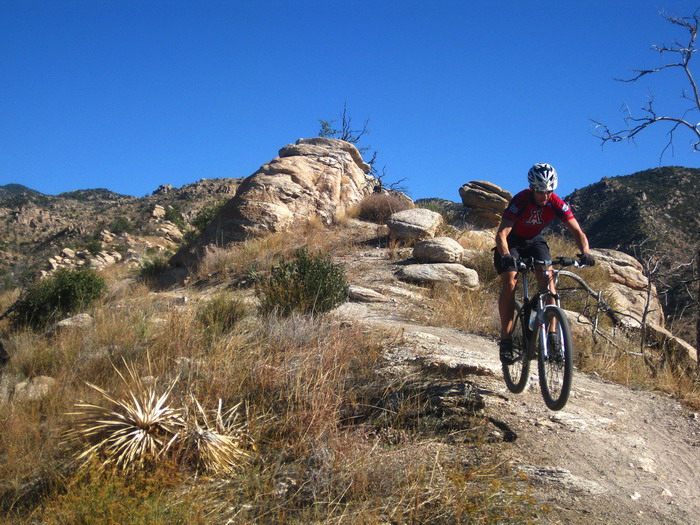
chad going huge on bug springs trail
The draft forest plan for the Coronado National Forest includes 10 new “potential wilderness areas.” Each has its own document, available here:
http://www.fs.fed.us/r3/coronado/plan-revision/plan-revision-documents.shtml
Most concerning among them are the Samaniego and East Catalina PWA (potential wilderness areas) that include such popular trails as Bug Springs, Green Mountain and a bunch of terrain in the 50 year trail area. Beyond those, other PWAs would shut out access to other prime trails such as the Cochise Stronghold trail in the Dragoons and an entire network of singletrack in the Chiricahuas.
The reports on the PWAs do not mention mountain biking as a current use, even though it is the primary use in several areas. This is the biggest reason we need mountain bikers to comment on the plans. And of course, if you do not support the closure of these areas to bike, voice your opinion that these wilderness areas should not even be considered.
I’m a little late to the party, as the comment period ends tomorrow (today by the time you read this, likely). Comments are due April 30th, 2010, by email to:
If you care about MTB access in Tucson, and especially if you’ve ridden Bug Spring or the 50 year trail area, please drop a note, even if it just says, “I have ridden my bicycle in several of these potential wilderness areas and I do not support wilderness designation.”
Thanks. Here’s my letter for reference.
To: Erin Boyle, Assistant Forest Planner
I would like to comment on several of the potential wilderness areas
outlined by the draft forest plan. First, many of them have a glaring
omission in the "current use" section. Mountain biking is not mentioned
as a current use in any of the documents. Yet, in some of the areas I
would argue that mountain biking is a primary use -- even higher usage
than hiking on some trails (specifically in the East Catalina PWA and the
Samaniego Ridge PWA).
I have personally enjoyed numerous mountain bike rides in the following
PWAs:
Dragoon Potential Wilderness Area
East Catalina Potential Wilderness Area
Mt. Wrightson Addition Potential Wilderness Area
North Chiricahua Potential Wilderness Area
Samaniego Ridge Potential Wilderness Area
Tumacacori Potential Wilderness Area
I know of many other mountain bikers who enjoy riding in these areas, as
well.
As a former wilderness ranger I have studied the wilderness act in detail
and have visited many wilderness areas by foot. I also enjoy long bicycle
rides and choose to live in Tucson due to the great opportunities for
mountain biking in this area.
In my opinion, none of the 10 wilderness areas outlined by the draft
forest plan are suitable for designation as wilderness. Roads criss cross
many of them, and signs of mining and other human intrusion run
throughout. Most are far too small to get any sense of being "out there"
or any true sense of solitude, as intended by the Wilderness Act of 1964.
Further, I do not see the need for these additional wilderness areas in
southern Arizona. Residents of metro Tucson already have sufficient
access to Pusch Ridge and Mt. Wrightson wilderness areas, both of which
have areas where it is easy to get away from 'the crowds.' Adding in other
regional wilderness areas to the picture gives a wealth of wilderness,
foot-only opportunities.
Meanwhile, mountain bike access is already severely limited by current
Wilderness areas. One prime example is the Arizona Trail.
Bikepacking (backpacking with a mountain bike) is becoming an increasingly
popular activity. Bikepackers following the Arizona Trail must detour
around wilderness areas (e.g. Mt. Wrightson and Pusch Ridge WA's), forcing
them to ride on busy and unsafe highways. Wilderness areas cause a
significant safety concern in this way. Traveling on busy roadways is
also emphatically not the experience that bikepackers are looking for.
For these reasons, I trust that none of the outlined potential wilderness
areas will be seriously considered or selected as preferred alternatives.
I urge that the evaluations be updated to accurately depict current
mountain bike use, as well.
Sincerely,
Scott Morris




Nice letter, wouldn’t hurt to tack on the title… speaking from letter writing experience.
Thanks for the link to USFS on this. Scott knows about where I, primarily a backpacker, stand here, but just to sort of play devil’s advocate for a moment…
Barring the MTB aspect (not that I really want to, and I do feel yer angst!), and having just hiked through a bunch of this terrain, I would submit that some of these areas really do have wilderness qualities and are worthy of permanent protection from undue “improvements or developments” and which Wilderness designation theoretically would be one means of accomplishing. The Dragoons are small and threatened by motor vehicle pressure, both legit and wayward, as well as by military overflights; the north Chiricahuas are arguably wilder and more remote than the area currently protected as Wilderness – they’re a “natural,” one might say; parts of the Tumacacoris (I’ve heard) are another “natural” for “belated” designation. Looking at the maps of the proposed area, I also see that the Galiuros, Chiricahua Addition (southern Chiricahuas), and I think (?) the Santa Rita extensions would be mostly academic, a means of filling in small irregularities to the original Wilderness areas with little or no consequence for users of the existing trail networks. (Correct me if I’m wrong.) The other areas I either can’t comment on or we’ve already been over the issue in email.
In the grand scheme, is anyone intentionally going after mountain biking in pursuing these new Wilderness designations, or does the potential exclusion of bikes in these areas follow from the law of unintended consequences, in this case from a proposal that may, in fact, have some merit, in terms of long-term preservation of areas near and dear to all non-motorized users? Framed another way, should mountain bike advocates risk being accused of throwing the proverbial baby out of the bathwater by condemning all of these proposed wild areas, or develop a more selective and concerted effort against those that are weakest in concept and most injurious in nature? Would it be more effective to work toward the selective removal of bicycles from the list of banned conveyances within certain Wilderness areas, or to point out other ways of achieving the kinds of protections that Wilderness designation is hoped to accomplish? The latter assuming, of course, that protection is at the head of the “theoretical” USFS agenda here, rather than something that will turn out to be mostly ceremonial, at least in some cases…
I guess, ultimately, I wonder whether hikers and equestrians have been brainwashed into thinking Wilderness designation actually does any good, since it is at least inclusive of them, or whether mountain bikers have been blinded to its true merits due simply to their own exclusion. I suppose the answer is a bit of both. That, and the nature of reality never quite living up to the perceived ideal. “If you have to manage wilderness, you’ve probably already lost it.” 😉
[…] Potential Wilderness Areas in Tucson « Diary of Scott Morris […]